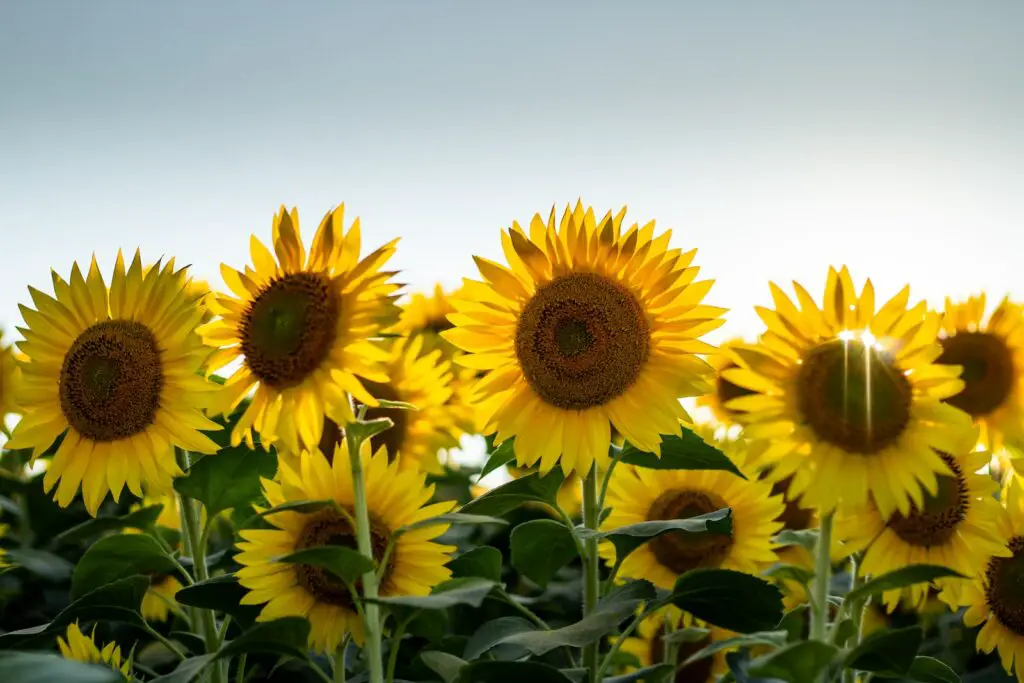
Sunflowers are one of the most recognizable flowers in the world, known for their bright yellow petals and brown centers. They are commonly grown in gardens and fields for their beauty and practical uses, such as producing oil and seeds. Many people wonder what month sunflowers bloom, as they want to plan their garden or visit fields during the optimal time.
Sunflowers typically bloom during the summer months, from June to August, depending on the location and climate. They require warm temperatures and plenty of sunlight to thrive, which is why they are commonly found in areas with long, hot summers. However, some varieties of sunflowers can bloom as early as May or as late as September, depending on the specific type of sunflower and growing conditions. It’s important to research the specific variety of sunflower being grown or visited to determine the best time to view their blooms.
Table of Contents
Understanding Sunflowers
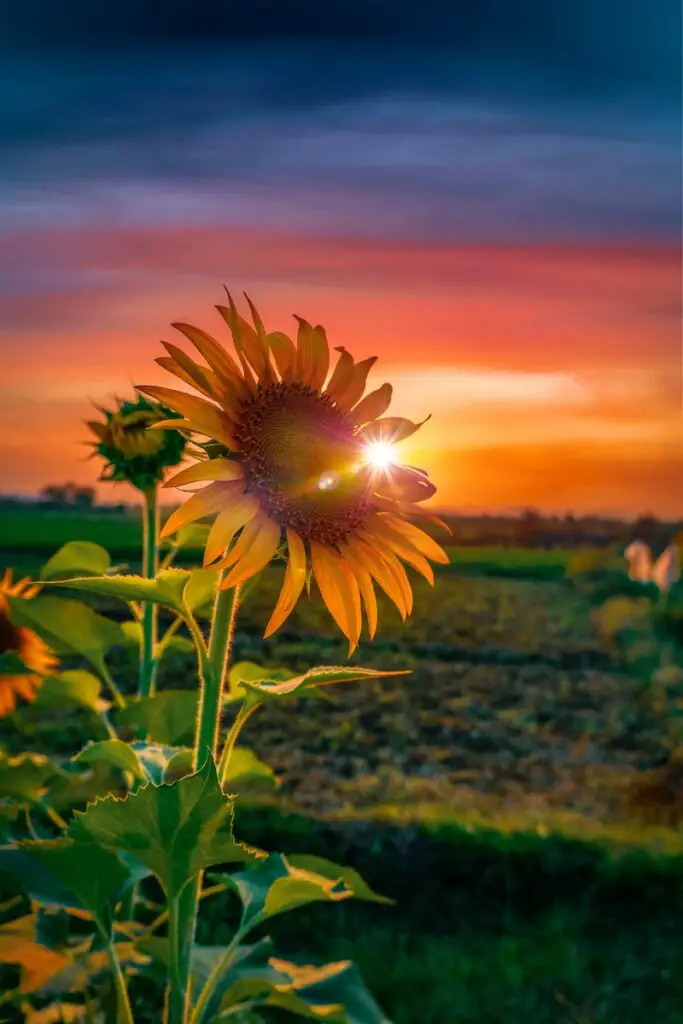
Sunflowers are a type of plant that is known for its bright yellow flower heads that resemble the sun. These plants are scientifically known as Helianthus annuus and belong to the family Asteraceae. They are an annual plant, which means they complete their life cycle in one growing season.
Sunflowers are known for their height, as they can grow up to 10 feet tall. They also exhibit heliotropism, which means they turn their heads to face the sun as it moves across the sky. This is an important trait for sunflowers, as it allows them to maximize their exposure to sunlight and photosynthesize efficiently.
There are many different types of sunflowers, including annual and perennial varieties. Some of the most popular types of sunflowers include the mammoth sunflower, which can grow up to 12 feet tall, and the dwarf sunflower, which only grows to be about 1-2 feet tall.
Sunflowers are also known for their seeds, which are a popular snack and ingredient in many foods. Sunflower seeds are rich in healthy fats, protein, and other nutrients, making them a nutritious addition to any diet.
In terms of blooming, sunflowers typically bloom in the summer months, specifically from June to August. However, the exact timing of blooming can vary depending on the specific variety of sunflower and the climate in which it is grown.
Overall, sunflowers are a beautiful and fascinating plant that have many unique characteristics and uses.
When Do Sunflowers Bloom
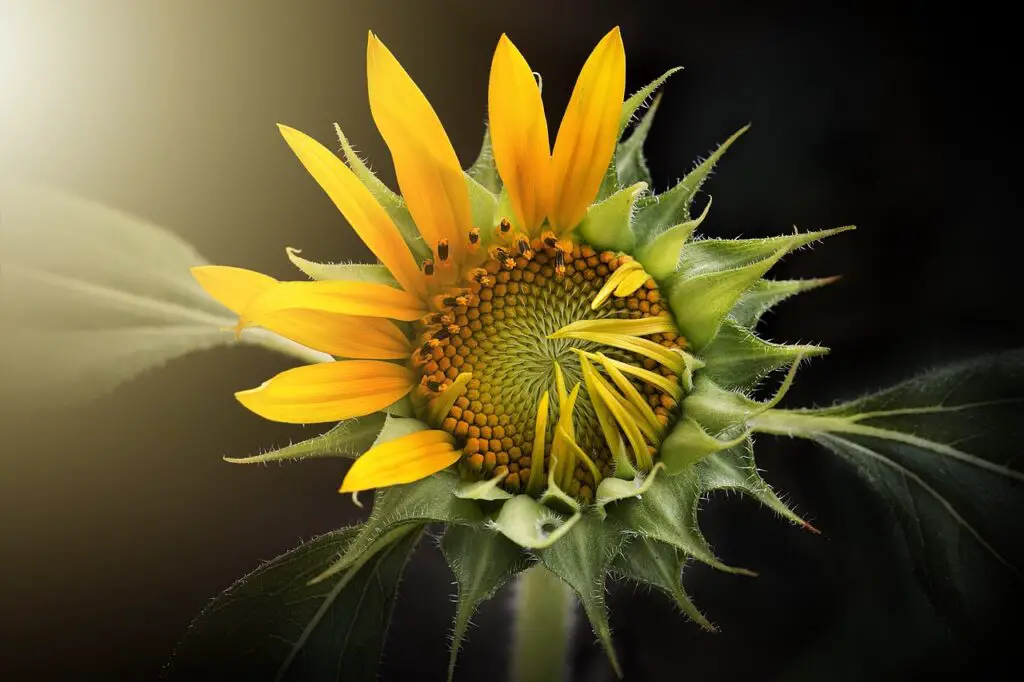
Sunflowers are known for their bright yellow petals and towering height, and they are a staple of summer gardens. However, the question of when sunflowers bloom can vary depending on a variety of factors such as location, weather, and planting time.
In general, sunflowers tend to bloom in the late summer or early fall, typically between the months of July and October. However, this can vary depending on where they are planted. In warmer areas, sunflowers may bloom earlier in the summer, while in cooler areas, they may bloom later in the fall.
Sunflowers also have different varieties that bloom at different times. For example, some varieties of sunflowers bloom in the spring, while others bloom in the summer or fall. It’s important to research the specific type of sunflower you are planting to determine when it will bloom.
The timing of when sunflowers bloom can also depend on when they are planted. If sunflowers are planted early in the spring, they may bloom earlier in the summer. However, if they are planted later in the spring or early summer, they may not bloom until the fall.
In terms of the stages of sunflower bloom, they typically go through several phases before reaching full bloom. These phases include the vegetative stage, where the plant grows leaves and stems, the reproductive stage, where buds form and petals begin to emerge, and the flowering stage, where the sunflower reaches full bloom.
Overall, the timing of when sunflowers bloom can vary depending on a variety of factors, but they typically bloom in the late summer or early fall. It’s important to research the specific type of sunflower you are planting and consider factors such as location and planting time to determine when they will bloom.
Ideal Growing Conditions
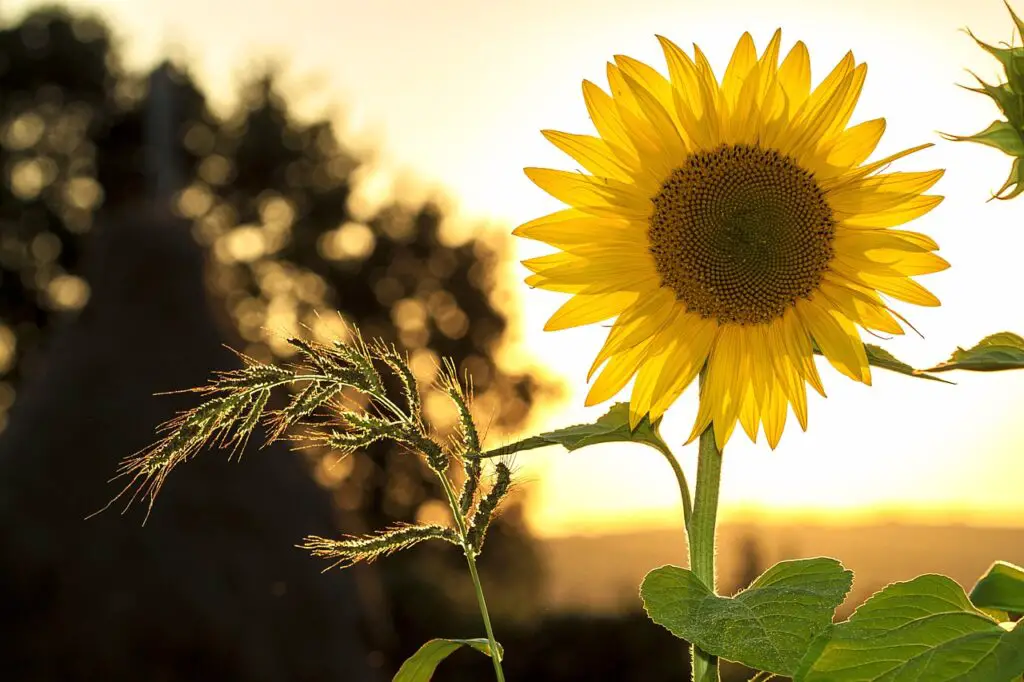
Sunflowers thrive in warm and sunny weather, making summer the ideal season for planting. They require full sun to grow, which means they need at least six hours of direct sunlight per day. This is why it’s important to choose a location that receives plenty of sunlight throughout the day.
In terms of soil, sunflowers prefer well-draining soil that is rich in nutrients. Loam soil is the best option as it provides a good balance of sand, silt, and clay. This type of soil allows for proper drainage while also retaining enough moisture for the sunflowers to grow.
Water is also essential for sunflowers to thrive. They require consistent watering, especially during the early stages of growth. However, it’s important not to overwater them as this can lead to root rot. A good rule of thumb is to water them deeply once a week, or more frequently during hot and dry weather.
Climate is another important factor to consider when growing sunflowers. They do well in areas with warm temperatures and low humidity. They can also tolerate some wind, but it’s important to provide them with some shelter from strong winds as they can easily topple over.
Overall, sunflowers require a sheltered location with well-draining soil, plenty of sunlight, and consistent watering. By providing these ideal growing conditions, you can ensure that your sunflowers will thrive and produce beautiful blooms.
Planting and Care
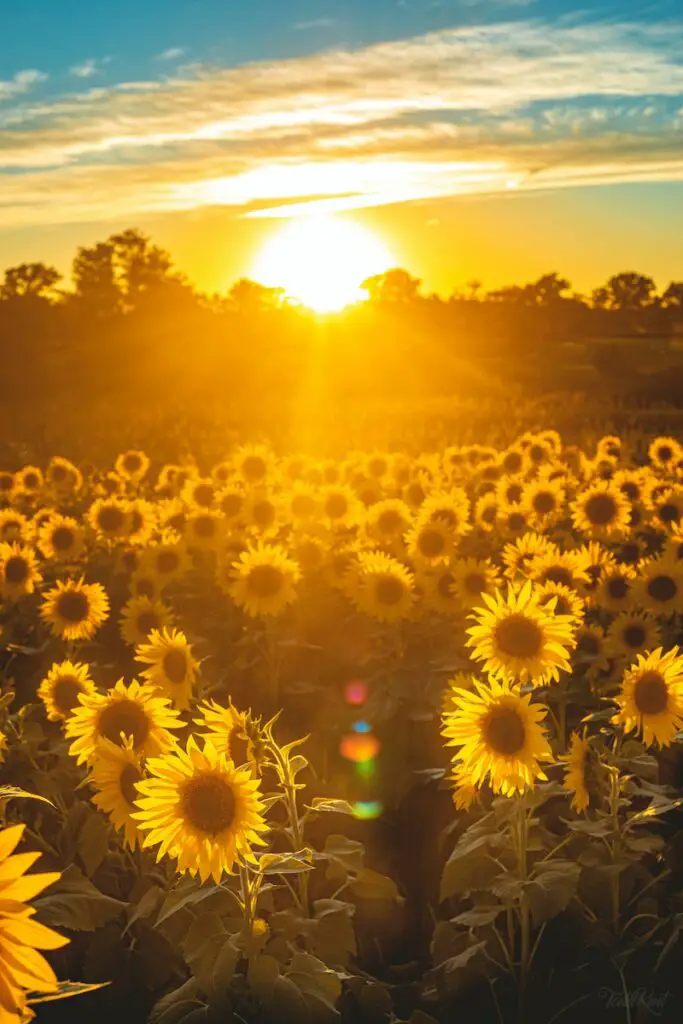
Sunflowers are easy to grow and care for, making them a great choice for both novice and experienced gardeners. Whether you plan to grow them indoors or outdoors, there are a few key things to keep in mind to ensure your sunflowers thrive.
Growing from Seeds
Sunflowers can be grown from seeds, which should be sown directly into the soil after the last frost. Alternatively, you can start the seeds indoors about 4-6 weeks before the last frost and then transplant them outside when they are about 6 inches tall.
When sowing the seeds, make sure to plant them about 1 inch deep and 6 inches apart. Water the soil well and keep it moist until the seeds germinate, which usually takes about 7-10 days.
Care and Maintenance
Once the sunflowers have germinated, they will enter the vegetative phase, during which they will grow leaves and stems. During this phase, it is important to provide them with plenty of water and organic matter to help them grow strong and healthy.
As the plants enter the reproductive phase, they will start to produce flowers. To ensure that the plants have enough nutrients to support the growth of the flowers, it is important to fertilize them with a slow-release granular fertilizer.
To keep the plants upright and prevent them from falling over, you may need to stake them with bamboo stakes. This is especially important if you are growing sunflowers in a flower bed or in an area with high winds.
Growing Tips
Here are a few additional tips to help you grow healthy and vibrant sunflowers:
- Water the plants deeply once a week, rather than giving them frequent shallow waterings.
- Plant sunflowers in an area with at least 6 hours of direct sunlight per day.
- Deadhead the flowers regularly to encourage the plants to produce more blooms.
- Avoid planting sunflowers near potatoes, as they can attract potato beetles.
Sunflower Varieties
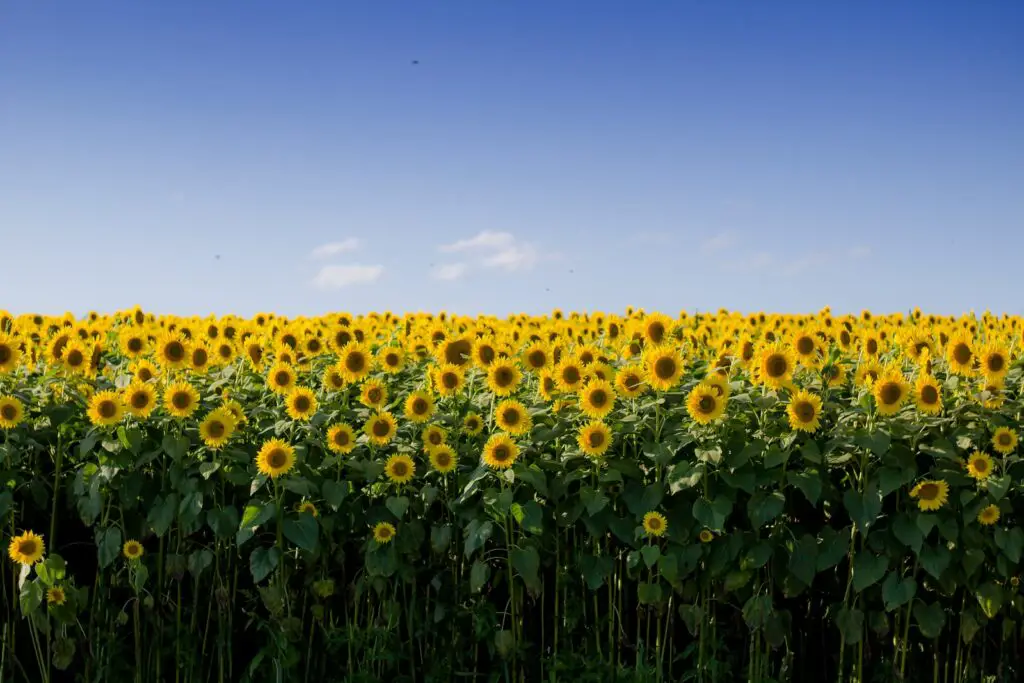
There are many different varieties of sunflowers that bloom at different times of the year. Some of the most popular varieties include:
Mammoth Sunflowers
Mammoth sunflowers are one of the largest varieties of sunflowers, growing up to 12 feet tall. They have large, bright yellow petals and brown centers. Mammoth sunflowers typically bloom in mid to late summer.
Autumn Beauty Sunflowers
Autumn Beauty sunflowers are known for their beautiful range of colors, including red, brown, and orange. They typically bloom in the fall, hence their name. These sunflowers can grow up to 6 feet tall.
Teddy Bear Sunflowers
Teddy Bear sunflowers are a dwarf variety that only grow to be about 2-3 feet tall. They have fluffy, round blooms that resemble teddy bears. These sunflowers typically bloom in the summer.
Lemon Queen Sunflowers
Lemon Queen sunflowers have bright yellow petals and dark centers. They typically bloom in mid to late summer and can grow up to 8 feet tall.
Italian White Sunflowers
Italian White sunflowers have white petals and dark centers. They typically bloom in mid to late summer and can grow up to 6 feet tall.
Mahogany Sunflowers
Mahogany sunflowers have deep red petals and dark centers. They typically bloom in mid to late summer and can grow up to 6 feet tall.
Dwarf Sunflowers
Dwarf sunflowers are a smaller variety that only grow to be about 1-2 feet tall. They come in a variety of colors, including yellow and orange. These sunflowers typically bloom in the summer.
Harvesting Sunflowers
Sunflowers are a popular plant for their bright yellow blooms and tasty seeds. When it comes to harvesting sunflowers, timing is key. Sunflowers typically bloom from mid-summer to early fall, with peak bloom time varying depending on the location and climate.
Once the sunflowers have bloomed and the petals have fallen off, it’s time to harvest the seeds. The seeds should be mature and dry, with the back of the flower head turning brown and the seeds themselves turning black or gray.
To harvest the seeds, cut the flower heads off the stalks and hang them upside down in a dry, well-ventilated area. This will allow the seeds to dry out completely and prevent mold or rot.
Once the seeds are dry, remove them from the flower head by rubbing them gently with your hands or using a fork to loosen them. Store the seeds in an airtight container in a cool, dry place.
Sunflower seeds can be enjoyed as a snack or used in a variety of recipes, from salads to trail mix. Harvesting sunflowers is a rewarding and enjoyable process that can provide a delicious and nutritious snack for months to come.
Sunflowers and Wildlife
Sunflowers are not only beautiful to look at, but they also play an important role in supporting wildlife. These plants attract a wide range of pollinators, birds, butterflies, and other insects, making them a valuable addition to any garden or natural area.
Pollinators, such as bees and butterflies, are attracted to sunflowers because of their bright colors and abundant nectar. These insects play a crucial role in the pollination of many plant species, including crops that are important for human consumption. By providing a food source for these pollinators, sunflowers help to ensure the health and sustainability of local ecosystems.
In addition to pollinators, sunflowers also attract a variety of bird species. Birds are attracted to sunflowers because of their high seed production. Sunflower seeds are a rich source of nutrients and energy, making them an important food source for many bird species. Some common birds that feed on sunflower seeds include finches, sparrows, and chickadees.
Sunflowers also provide an important food source for humans. Sunflower seeds are a popular snack and are also used in a variety of culinary dishes. In addition, sunflower oil is commonly used in cooking and is a healthy alternative to other cooking oils.
Overall, sunflowers play an important role in supporting wildlife and are a valuable addition to any garden or natural area. By attracting pollinators, birds, and other insects, sunflowers help to ensure the health and sustainability of local ecosystems.
Potential Challenges

While sunflowers are generally easy to grow and care for, there are some potential challenges that growers should be aware of. These challenges include:
Frost
Sunflowers are sensitive to frost and can be damaged or killed by it. Therefore, it is important to plant them after the last frost date in your area. In cooler climates, sunflowers may not bloom until late summer or early fall, so it is important to take this into account when planning your planting schedule.
Fertilization
Sunflowers require regular fertilization to thrive. However, too much fertilizer can cause problems such as rust and drooping. It is important to follow the recommended fertilization schedule and to use the right type of fertilizer for your soil.
Drought
Sunflowers are drought-tolerant, but they still require regular watering, especially during the early stages of growth. If they do not receive enough water, they may not bloom or may produce smaller flowers.
Strong Winds
Sunflowers can be damaged by strong winds, especially if they are tall and top-heavy. To prevent damage, it is important to stake the plants or provide some other type of support.
Drooping
Sunflowers can droop if they do not receive enough water or if they are top-heavy. To prevent drooping, it is important to water the plants regularly and to provide support if necessary.
Overall, sunflowers are relatively easy to grow and care for, but it is important to be aware of these potential challenges in order to ensure a successful harvest.
Uses of Sunflowers
Sunflowers have a wide range of uses, from ornamental to practical. Below are a few examples of how sunflowers are utilized:
Cut Flowers: Sunflowers are commonly used as cut flowers due to their vibrant colors and long vase life. They are often used in floral arrangements and bouquets.
Pollen-Free: Some sunflower varieties are bred to be pollen-free, making them a great option for those with allergies. These varieties are also less messy and easier to maintain.
Bouquets: Sunflowers are often used in bouquets due to their large size and striking appearance. They can be paired with other flowers or used alone for a bold statement.
Edible Seeds: Sunflower seeds are a popular snack and can be found in a variety of flavors. They are also used in cooking and baking, adding texture and flavor to dishes.
Warm Summers: Sunflowers thrive in warm summers and are often used as a crop for their oil-rich seeds. Sunflower oil is used in cooking and is also used in the production of biodiesel.
Overall, sunflowers are a versatile plant with many uses. Whether you are looking for a beautiful addition to your garden or a tasty snack, sunflowers have something to offer.